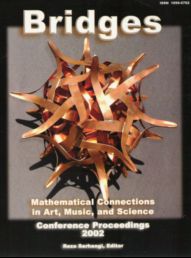
Bridges 2002
Towson, Maryland, USA
27–29 July 2002
More information
Front matter
Sculptural Interpretation of a Mathematical Form
Pages 1–8
Color Dependent Computational Aesthetics for Evolving Expressions
Pages 9–16
Set Operations in the Music of Nikolai Roslavets
Pages 17–24
A Transformation Sketchbook
Pages 25–36
3D Visualization Model of the Regular Polytopes in Four and Higher Dimensions
Pages 37–48
The Pi Symphony: Numeric Sequences in Music
Pages 49–53
Computer Sculpture: A Journey through Mathematics - Abstract
Pages 54–54
The Endless Wave
Pages 55–66
Geometric Patterns and the Interpretation of Meaning: Two Monuments in Iran
Pages 67–78
Two Poems
Pages 79–81
Time-Space of Music - Abstract
Pages 82–82
Exploring Fractal Geometry in Music
Pages 83–90
Electrostatic Kaleidoscope
Pages 91–98
Layering Fractal Elements to Create Works of Art
Pages 99–108
Spatial Constructs
Pages 109–115
An Introduction to Polynomiography - Abstract
Pages 116–116
Gridfield Geometry
Pages 117–122
Hearing With Our Eyes: The Geometry of Tonal Space
Pages 123–134
Art in Perspective: A Making Connections Cluster at Clarion University
Pages 135–142
A Collaborative Parabolic Quilt
Pages 143–149
A Course: Mathematics and the Visual Arts - Abstract
Pages 150–150
Vasarely Design and Other Non-Cubical Designs
Pages 151–156
A Mathematical Analysis of African, Brazilian, and Cuban Clave Rhythms
Pages 157–168
The Knight's Tour Problem as a Conceptual Tool for Interdisciplinary Studies
Pages 169–180
Fractions in Art and Mathematics
Pages 181–188
Transforming Some Infinite Polyhedra
Pages 189–195
Poseidon from Cape Artemision - Abstract
Pages 196–196
168 Butterflies on a Polyhedron of Genus 3
Pages 197–204
Preliminary Field Explorations in K-6 Math-Ed: The Giant Triangles as Classroom Manipulatives
Pages 205–212
Exploring the Effect of Direction on Vector-Based Fractals
Pages 213–219
Choosing Diagrams for the Book of Beautiful Mathematical Diagrams - Abstract
Pages 220–220
Anne Bulckens' Analysis of the Proportions of the Parthenon and its Meanings
Pages 221–226
A Musical Suite Based on the Platonic Solids
Pages 227–233
Exploring Algebra with Creative Designs - Abstract
Pages 234–234
The Rootsellers - Retelling the Galois Group of Quartic Polynomial
Pages 235–246
Mathematics for Those Who Hate Mathematics
Pages 247–255
Sentences on the Aesthetics of Mathematics and Art - Abstract
Pages 256–256
From a Subdivided Tetrahedron to the Dodecahedron: Exploring Regular Colorings
Pages 257–261
Connecting Mathematics and the Arts in the Elementary Classroom through Movement - Abstract
Pages 262–262
How a Math Class Can Be Two Places at Once: A Proposed Mathematical/Philosophical Collaboration
Pages 263–268
A Museum Dedicated to the Concept of Harmony and the Golden Section
Pages 269–276
Techniques for Artistically Rendering Space-Filling Curves
Pages 277–283
Pure-Tone Approximation to Equal-Temperament: How Close is Close? - Abstract
Pages 284–284
A Mathematical Look at the 7 Liberal Arts as Humanities
Pages 285–292
Tonal Optimization in Music Playing
Pages 293–300
Beautiful Mind - Elegant Bridge
Pages 301–304
Graphical Fractals Based on Circles - Abstract
Pages 305–305
Theory and Application of Islamic Star Patterns - Abstract
Pages 306–306
Art and Physics: Parallel Visions in Space, Time and Light - Abstract
Pages 307–307
How to Make the Juno's Spinner - Abstract
Pages 308–308
Towards a Geometrical Way of Thinking - Abstract
Pages 309–310
Heterarchy of Space - Abstract
Pages 311–311
Kindred Spirits: Hafez in His Poetry, Mathematicians in Their Theories - Abstract
Pages 312–312
Theory of Design - Abstract
Pages 313–313
On the Shapes of Water Fountains and Times Tables - Abstract
Pages 314–314
Experimental Morphology: The Generative Dynamics of Form and Structure
Pages 315–318
Real Kecak Systems - Abstract
Pages 319–319
About Enumeration of Isogonal Polyhedral Families - Abstract
Pages 320–320